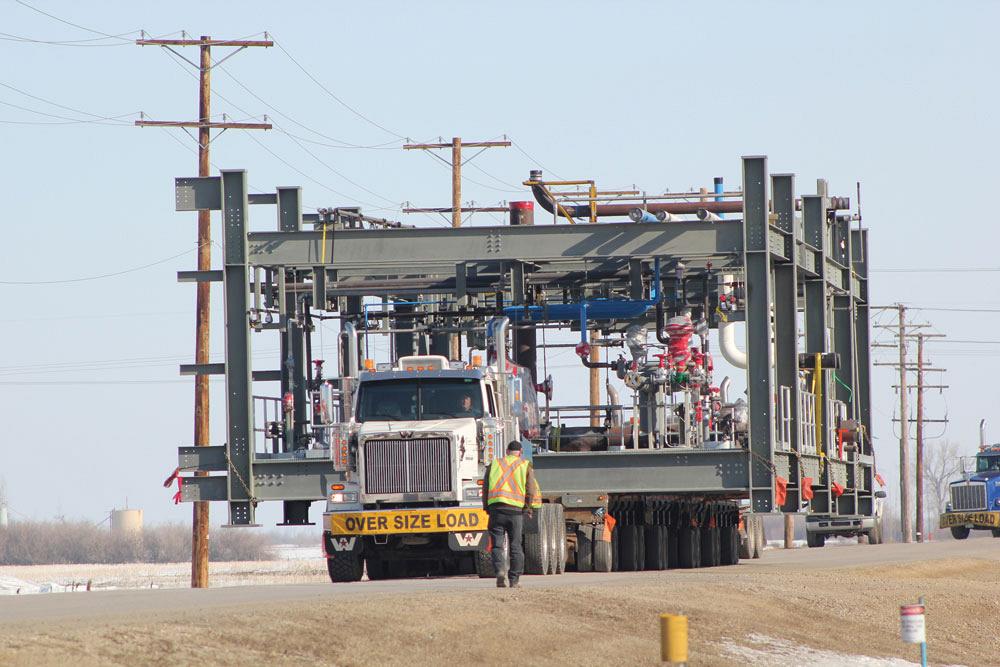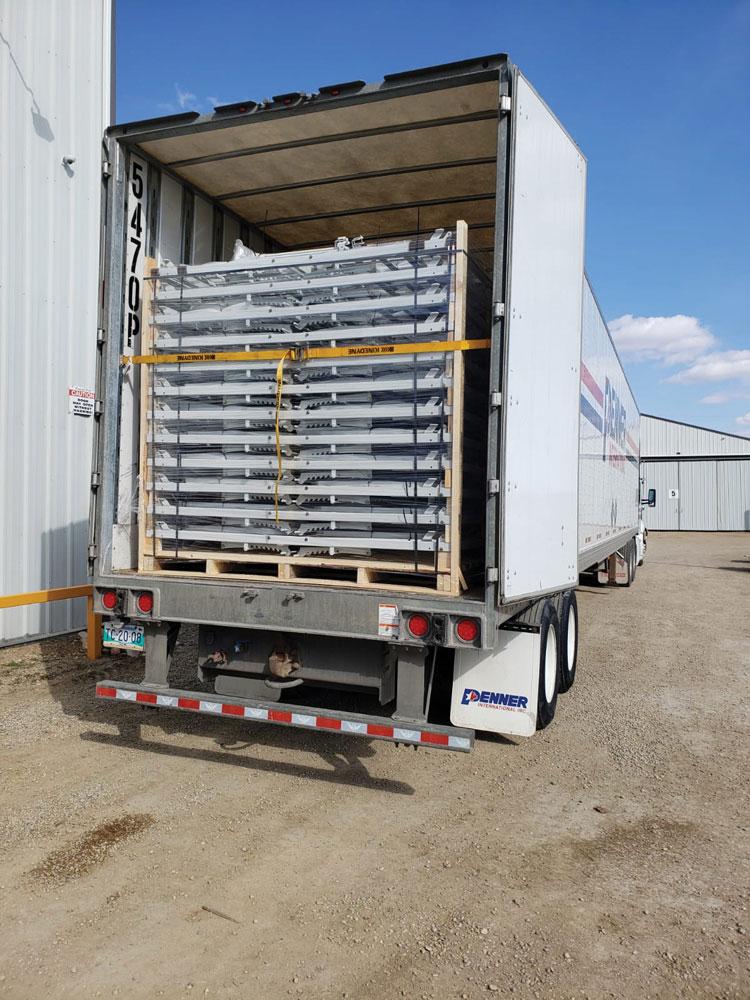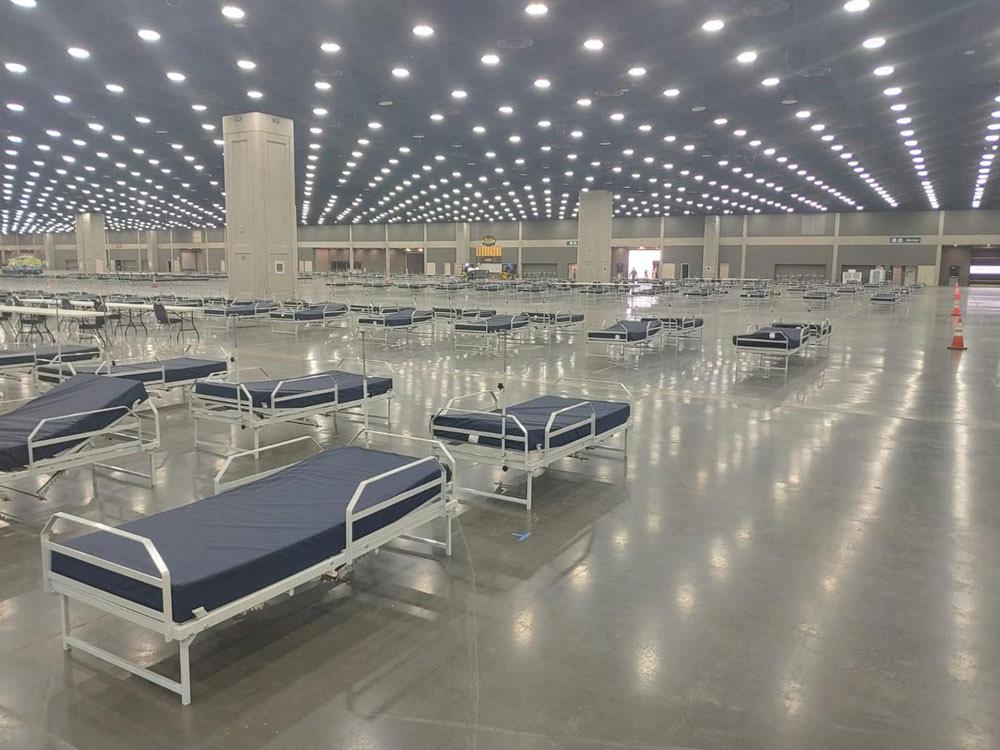Editor
- FMA
- The Fabricator
- FABTECH
- Canadian Metalworking
Saskarc’s nimble pandemic response
Company uses engineering know-how, automation to rejig factory for mass production
- By Rob Colman
- September 8, 2020
- Article
- Fabricating

In April Saskarc produced and distributed more than 10,000 beds from its shops, coupled with its local Western Canadian subcontractors. Together with its U.S. partners, it combined to produce 30,000 beds, shipping them to locations across Canada, the U.S., and internationally. Retooling the shop floor for production was achieved in less than a week.
Oxbow, Sask.-based Saskarc has been in business 30 years as a large-scale structural and platework metal fabricator. Recently the needs of the COVID-19 pandemic have pushed the company to retool one of its shop floors to satisfy new market demands: emergency field hospital beds and then hand sanitation stations. The Saskarc team’s ability to do this rapidly is a testament to its agility, but also the investments the company has made in automation and software that allow effective communication on and off the shop floor.
Investing In Competitive Advantages
With its large fabricating capacity and a dedicated engineering and project delivery team, Saskarc meets a range of project demands in the heavy civil and industrial construction, power generation, mining, and petroleum industries. It has developed a solid reputation for innovative solutions that expand beyond a typical fabricator’s scope to meet the needs of customers.
Big projects like these aren’t immune to market pressures, of course.
“With oil prices dropping, commodity prices dropping, and now a global pandemic, there is ever greater pressure on keeping costs down for customers,” said Roy Drever, general manager at Saskarc. “Customers still expect on-time delivery and high-quality products and service, but the price has to be right.”
To stay competitive while at the same time capturing a broader market – such as structural steel work for industrial and commercial construction like mines, power stations, food processing facilities, hospitals, high-rises, and arenas – the Saskarc team spent 18 months researching and investing in the latest automation and technology to increase its efficiency and production capacity. Although Drever kept the details of the investments under wraps, he noted that some of them were advanced technology that is currently used in only a handful of shops across North America, “but in a few years it will be impossible to compete without it.”
One upgrade on the shop floor that he did note is the use of tablets to manage drawings and production flow.
“Everyone on the production floor, whether they are in material preparation, fitting, or welding, is updating information on their tablets regularly,” said Drever. “When they finish a process, they will update the software on their tablet so that we have live data at all times. This means that our project managers can go in and see exactly what materials have been ordered, received, processed, QC checked, painted, and so forth. If we are having a client meeting, we can show them the progress of their job in real time. They can see colour-coded indications of what is in production, what is in blast/paint, and what is in the yard ready to ship.”
Drever saw early on how this helped his team.
“We started a project recently and saw, within 24 hours, that it wasn’t running as we expected it should,” he said. “Without this technology, the issue we picked up on might have gone unnoticed for days. That’s the great thing about this technology; 24 hours into a job, it’s very easy to adjust for any issue and you can easily get a job back on track, and that’s what we did.”

With its large fabricating capacity and a dedicated engineering and project delivery team, Saskarc meets a range of project demands in the heavy civil and industrial construction, power generation, mining, and petroleum industries. Here we see a project for four large pipe modules being shipped to a customer in the power generation industry.
Pandemic Shift
In the midst of rolling out its shop upgrades, Saskarc found itself, like everyone else, meeting the pandemic head-on. Drever said they saw a “considerable need” across North America for emergency relief beds. At the same time, the company was concerned about keeping its staff employed in the short term if everything continued to slow due to COVID-19. Addressing the need seemed like an ideal solution to both problems.
To ramp up production and distribution quickly, Saskarc teamed up with two large U.S. manufacturers to form a joint venture called Fastbeds.
“The name Fastbeds pretty much explained exactly what we needed to deliver,” said Drever. “And we scaled up production almost overnight.”
Saskarc is first and foremost a supplier to its customer, so before the ramp-up started, the team reached out and explained the situation to clients.
“We talked to our existing customers who had jobs in progress in the shop and explained the situation to them,” said Drever. “We explained that we needed to push out some of their work and delay it for this production and they were very understanding. In some cases, they even went to their clients to see about having schedules on their orders pushed out. This allowed Saskarc to free up one whole shop over a weekend, clean it out, wash it all down, and prep four manufacturing lines.”
Drever speaks very highly of both his production team and lean continuous improvement manager, who made the shop floor transformation and bed design come together so quickly.
“It took days to scale up to the throughput we needed because that type of automotive-like mass production fab work is very different from what we’re used to doing, but we got there,” he said. “But the initial discussion with our partners started on Wednesday and by the following week we were running production. Our joint venture’s combined engineering team worked around the clock to develop the design, prototype it, and test it in those first few days.”
In April Saskarc produced and distributed more than 10,000 beds from its shops, coupled with its local Western Canadian subcontractors. Together with its U.S. partners, it combined to produce 30,000 beds, shipping them to locations across Canada, the U.S., and internationally.
A Second Pivot

Fastbeds were designed for compact shipping and simple setup. He we see a shipment of the beds loaded to go.
When the need for beds tapered off, the company pivoted again to fill a gap for hand sanitation stations.
“Our team recognized that as people started returning to work, going back to shopping centres and other public places, there would be a greater need for hand sanitizer to combat a second wave,” said Drever. While before you might have carried a small bottle of sanitizer with you when you went on a plane, it is now a more widespread phenomenon. To satisfy this growing need, the Saskarc team, again with its partners, developed a range of sanitizer dispensers for low-, medium-, and high-traffic areas.
“Since this is a new development, people are unfamiliar with the requirements of sanitation units, so we saw that we could provide a turnkey solution and also supply them with sanitizer to fill their stations,” said Drever.
Through their partners and affiliations, they made it happen.
“Like with the hospital beds, our engineering team really came together to understand market needs and adjust to that,” said Drever.
Agility Boost
Coming at a time when Saskarc was already in the midst of making changes in its own production processes, Drever said he’s seen some positive shifts on the shop floor.
“We learned a number of lessons from the bed work that we’ve adopted in our day-to-day projects,” said Drever. “For instance, we now have fast, 10-minute, stand-up meetings every morning with all stakeholders on a project. It’s an opportunity to go through any concerns and ideas for changes to make us more efficient. This has worked quite well. This way we are constantly challenging how we do things, and we don’t run the risk of reverting to how we did things previously. We just constantly say to ourselves that there’s a better way to do things.”
Saskarc already had a lean process manager and a dedication to that process, but Drever thinks that the pandemic situation brought the whole team together and made it possible for everyone to see the value of it even more clearly.
“It’s all happening a lot faster than it might have otherwise,” he said. “Success breeds success, as the saying goes. That’s what we’ve seen through this – a lot of successes leading to a faster pace.”
Drever is also aware that it’s this dedication to success that Saskarc’s customers depend on from any supplier.
“It’s more and more important to be a problem-solver for customers,” he said. “It’s important that you look at the best way to get a job done, not just do it the way you’ve always done it. For instance, in designs for a lot of our customers we have to look at the requirements and say, ‘How can we change the connections, what’s the best material available for the job, and how can it all connect so that it mitigates the amount of work that needs to be done out in the field, where it’s more costly?’ All the work we’ve done through the pandemic shows how effectively and rapidly we can do that when asked to.”
The market continues to be tough for Saskarc, with projects getting pushed out or delayed, but this agility has allowed it to keep a healthy team of 75 working throughout this year thus far.
“We were fortunate that we were able to react quickly to market needs,” said Drever. “Thanks to our customers for working with us to allow this to happen.”
Editor Robert Colman can be reached at rcolman@canadianfabweld.com.
Saskarc, saskarc.com
About the Author

Rob Colman
1154 Warden Avenue
Toronto, M1R 0A1 Canada
905-235-0471
Robert Colman has worked as a writer and editor for more than 25 years, covering the needs of a variety of trades. He has been dedicated to the metalworking industry for the past 13 years, serving as editor for Metalworking Production & Purchasing (MP&P) and, since January 2016, the editor of Canadian Fabricating & Welding. He graduated with a B.A. degree from McGill University and a Master’s degree from UBC.
subscribe now


Keep up to date with the latest news, events, and technology for all things metal from our pair of monthly magazines written specifically for Canadian manufacturers!
Start Your Free Subscription- Trending Articles
Aluminum MIG welding wire upgraded with a proprietary and patented surface treatment technology

Achieving success with mechanized plasma cutting

Hypertherm Associates partners with Rapyuta Robotics

Gema welcomes controller

Brushless copper tubing cutter adjusts to ODs up to 2-1/8 in.

- Industry Events
MME Winnipeg
- April 30, 2024
- Winnipeg, ON Canada
CTMA Economic Uncertainty: Helping You Navigate Windsor Seminar
- April 30, 2024
- Windsor, ON Canada
CTMA Economic Uncertainty: Helping You Navigate Kitchener Seminar
- May 2, 2024
- Kitchener, ON Canada
Automate 2024
- May 6 - 9, 2024
- Chicago, IL
ANCA Open House
- May 7 - 8, 2024
- Wixom, MI
















